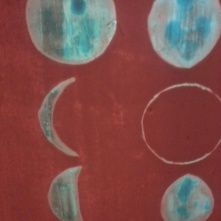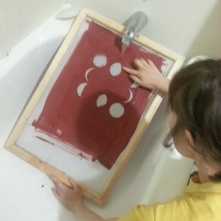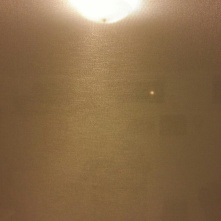In Richard Sennett’s The Craftsman, he says of the workshop that the “workshop is the craftsman’s home. Traditionally and literally so” (53). In previous posts, I have mentioned the not so desirable workspace I have for printing – my (low) kitchen table in my kitchen.
My last round of prints, which were of two small designs, took a total of seven hours from start to finish: sketching, painting drawing fluid, drying, painting screen filler, drying, making the prints, washing the screen (this doesn’t include the amount of time it takes for me to convert my “workshop” back into my kitchen, or my “washing station” into my shower. Both spaces need to be cleaned and reassembled after this process.) During this time I am on my feet. I’m not sure of the physical/body reasons for this, but sitting to print seems improbable to me. Here is where a technical account should occur, but I haven’t the language for it, so put crudely: I don’t have the same control and dexterity of my hands (and what they’re doing is remarkable in range) and arms sitting, especially at my low table. And given that this workshop is actually my kitchen and is small (and occupied by two curious cats that watch on), I am back and forth washing my limited amount of tools, my hands so as to not sully the process or product, and the screen as it advances in the process.
When I print, I am enjoying myself. I am listening to Radiolab or music and I get absorbed into the process, that is until physically I am pulled out of my head and made aware of my body: back ache. Printing in my workshop space is grueling on my back, but for the most part I do not focus on this, I instead focus on the progress of the print. I typically take a break about halfway through the move to the living room to stretch and lie on the floor a minute to give my back a break. This last time though, despite feeling just about everything that is able to crack in my neck, shoulders, back and wrists pop, one side of my back and neck went into a state of cold numbness and I was forced in that moment to think about my workspace. Printing requires much from my body for the process, not just my hands, but movements that involve my arms, wrists, shoulders, and back. Craft does require the body as an integral part of the making, and I had never been made so aware of my own body then I was in this moment. I thought, this is why space matters, this is why workshops aren’t often transferable to any space – there are conditions that must be attended to. Craftspersons have established workplaces because the process is involves and requires certain material conditions. While I have been able to make without some of these elements, if I am to continue doing this (and I would like to) I have to envision the space and conditions of doing it as I view the process of making – with care. While I don’t think this quite gets to the naturalism of John Ruskin, I do find myself uninspired by my transitory kitchen workshop, which I feel in my craft. Each part of the process becomes felt, no longer embodied, I am aware of time passing and time left to take, and begin thinking about the transformation back into cooking and eating space and the scrubbing of paint and Speedball Cleaner from my bathtub before it can be used again. This is hardly the imagination necessary for designing and making.
A parting word on ventilation: it’s critical. I think about my dad’s workshop in the garage – “industrial” surfaces that are easy to clean, high ceilings, many windows and or/door to open, waist high and lower chest high work surfaces. It’s part in the garage because we don’t have room in our tiny house for a workshop, partly because of the nature of much of my dad’s work – wood work, welding, working on cars and the like, and part because of the materials and solvents he’s working with. Printing itself, although using chemical materials, isn’t as noticeable, but the cleaner is. In my tiny bathroom with a functionless (it lets some light in) window, the steam created from cleaning the screen fills the room. I have yet to clean a screen without getting a headache, and I think it’s attributed to the cleaning agent. While this isn’t a universal requirement of printing, I think there is a reason many print workshops are in more open industrial settings aside from space to set up the many materials – air circulation and ventilation. This, like my workshop space, has been something I’m dealing with because I don’t have other resources available, but it is not sustainable space.
Next apartment criteria: a workshop space (and a taller table) so I can live in my living space and in my working space and not an uncomfortable transitory space in between that seems to be at odds with both.



































